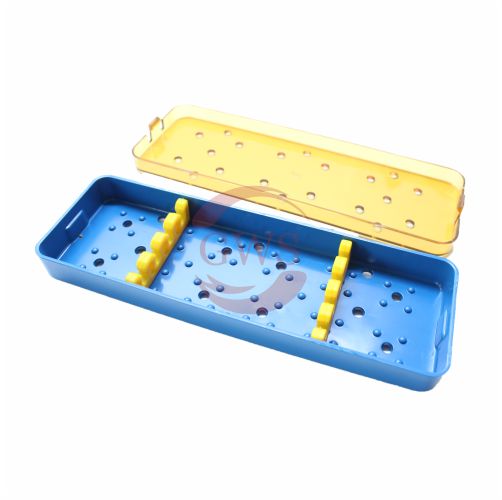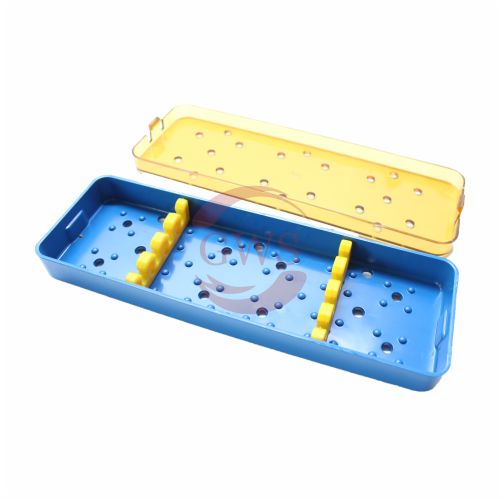When devices are used inside body. The surgical area is very much exposed to the environment, with elevated risk for infection. Alterations of body tissues using the instruments is a huge source of possible introduction of pathogens. That is why all instruments and materials that come directly in contact with the site should be free from organisms. Sterilization tray also helps in decreasing the possibility of contamination. There are lots tools that can be reused, and are too costly and impractical to discard after one time use. Such items include metallic tools like forceps and scissors. These items are cleaned, and placed on various types of trays for sterilization.
These trays help make the process a lot simpler. Instruments are lined up along it to keep them in place during the process. The instruments should not be touching, to allow gas or steam to freely circulate between. There are different types of sterilization trays used in autoclaves also. Micro trays are best for small and difficult to track. There are perforated ones that allow steam to penetrate the device and circulate within. Some trays are made of high quality, medical grade plastic for economic purposes. There are see-through type that allow for easy visibility of the tools. The most common ones are made of steel.

These trays are very durable and can withstand the difficult conditions. It is best used for autoclave and gas sterilization methods. There is also the standard perforated instrument types best used for autoclave and cold sterilization. Cold sterilization is soaking devices in chemicals. This type is best for tools called sharps, whose sharpness can get worsened when subjected to extreme conditions. Devices to be soaked in chemicals should still be thoroughly dried before soaking. Time of soaking depend on the type, amount of contamination and the type of solution.
USE OF AUTOCLAVES IN CLINICAL SETTINGS
Sterilization is a very essential process. It is a process of killing all possible contaminants like in instrument trays. They are living organisms that may have been harbored by a particular instrument. All instruments that come in direct contact with the body need to be sterilized before use. Sterilization can be achieved using physical and chemical means and are done by placing the instruments on trays. It distinct from disinfection, and pasteurization, in that those methods reduce rather than eliminate biological agents present. After sterilization, an object is referred to as being aseptic. It can be achieved with steam, heat and chemicals.
Autoclaving is one of the most commonly used sterilization techniques. Reusable instruments are dried, then lined on trays. The tray is covered with cloth and then placed for steam to kill all the pathogens. Gas sterilization uses ethylene oxide to sterilize. This method is used for instruments that are heat sensitive. An autoclave is a device used to carry out scientific processes requiring high temperature and pressure in relation to ambient temperature.
They are used before surgical procedures to perform sterilization on trays. The high heat and pressure that it generate help to ensure that the best possible physical properties of trays are repeatable. Different types of autoclaves are used to grow crystals under high temperatures and pressures. Synthetic quartz crystals used are grown in autoclaves.
BENEFITS OF THIS PROCESS ON MEDICAL TRAYS
Clinical settings, especially wards and rooms, require sterile devices to function. Autoclave sterilization is necessary because hospital facilities need a reliable way to clean medical devices between patients to prevent infection. When patients go to a medical facility, they expect to receive treatment for their illnesses, not to become sick. However, the Centers for Disease Control report that at any given time, about one out of every hundreds of hospitalized patients has an acquired infection. Though using the right autoclave from a good hospital equipment supplier cannot solve the challenges associated with bacteria or pathogens, it can avoid dangerous illnesses from spreading via reused medical equipments. For instance, a patient undergoing medical procedures will have the peace of mind of knowing the blade used for the procedure is free from hazardous contaminants.
Autoclave sterilization is a right choice in medical and laboratory settings because it is very eco-friendly. It consumes power as it runs. Still, it sterilizes instruments effectively without harsh reagents that are environmentally non friendly and could pose the serious health risks. It also enables the reuse of many different types, eliminating disposable ones and cutting down on waste.
CONCLUSION
Thus, when the autoclave cycle is finished, follow the following precautions: Put on protection equipment such as lab coat, closed-toe shoes and eye protection Do not open the door, not unless the pressure gauge has dropped to zero. Opening the door with caution and allowing steam to escape first before removing the custom procedure trays. Letting liquids stand for ten to twenty minutes after opening. The process of autoclaving is very useful in the sterilization of biomedical waste before disposing off. This method is mostly recommended than incineration because incinerators are inclined to raising health concerns.
